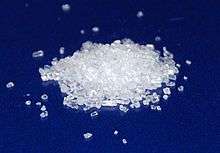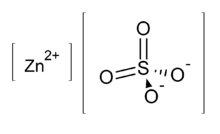Zinc sulfate
Zinc sulfate is an inorganic compound and dietary supplement. As a supplement it is used to treat zinc deficiency and to prevent the condition in those at high risk.[3] Side effects of excess supplementation may include abdominal pain, vomiting, headache, and tiredness.[4]
 | |
 | |
| Names | |
|---|---|
| IUPAC name
Zinc sulfate | |
| Other names
White vitriol Goslarite | |
| Identifiers | |
| |
3D model (JSmol) |
|
| ChEBI | |
| ChEMBL | |
| ChemSpider | |
| ECHA InfoCard | 100.028.904 |
| EC Number |
|
PubChem CID |
|
| RTECS number |
|
| UNII | |
| UN number | 3077 |
CompTox Dashboard (EPA) |
|
| |
| |
| Properties | |
| ZnSO4 | |
| Molar mass | 161.47 g/mol (anhydrous) 179.47 g/mol (monohydrate) 287.53 g/mol (heptahydrate) |
| Appearance | white powder |
| Odor | odorless |
| Density | 3.54 g/cm3 (anhydrous) 2.072 g/cm3 (hexahydrate) |
| Melting point | 680 °C (1,256 °F; 953 K) decomposes (anhydrous) 100 °C (heptahydrate) 70 °C, decomposes (hexahydrate) |
| Boiling point | 740 °C (1,360 °F; 1,010 K) (anhydrous) 280 °C, decomposes (heptahydrate) |
| 57.7 g/100 mL, anhydrous (20 °C) (In aqueous solutions with a pH < 5)[1] | |
| Solubility | alcohols |
| −45.0·10−6 cm3/mol | |
Refractive index (nD) |
1.658 (anhydrous), 1.4357 (heptahydrate) |
| Thermochemistry | |
Std molar entropy (S |
120 J·mol−1·K−1[2] |
Std enthalpy of formation (ΔfH⦵298) |
−983 kJ·mol−1[2] |
| Pharmacology | |
| A12CB01 (WHO) | |
| Hazards | |
| Safety data sheet | ICSC 1698 |
EU classification (DSD) (outdated) |
Harmful (Xn) Dangerous for the environment (N) |
| R-phrases (outdated) | R22, R41, R50/53 |
| S-phrases (outdated) | (S2), S22, S26, S39, S46, S60, S61 |
| NFPA 704 (fire diamond) | |
| Flash point | Non-flammable |
| Related compounds | |
Other cations |
Cadmium sulfate Manganese sulfate |
Related compounds |
Copper(II) sulfate |
Except where otherwise noted, data are given for materials in their standard state (at 25 °C [77 °F], 100 kPa). | |
| Infobox references | |
It has the formula ZnSO4 as well as any of three hydrates. It was historically known as "white vitriol". All of the various forms are colourless solids. The heptahydrate form is commonly encountered.[5]
Uses
Medicine
In medicine it is used together with oral rehydration therapy (ORT) and an astringent.[5]
Manufacturing
The hydrates, especially the heptahydrate, are the primary forms used commercially. The main application is as a coagulant in the production of rayon. It is also a precursor to the pigment lithopone.
It is also used as an electrolyte for zinc electroplating, as a mordant in dyeing, and as a preservative for skins and leather.
Other
Zinc sulfate is used to supply zinc in animal feeds, fertilizers, toothpaste, and agricultural sprays. Zinc sulfate, like many zinc compounds, can be used to control moss growth on roofs.[6]
Zinc sulfate can be used to supplement zinc in the brewing process. Zinc is a necessary nutrient for optimal yeast health and performance, although it is not a necessary supplement for low-gravity beers, as the grains commonly used in brewing already provide adequate zinc. It is a more common practice when pushing yeast to their limit by increasing alcohol content beyond their comfort zone. Before modern stainless steel, brew Kettles, fermenting vessels and after wood, zinc was slowly leached by the use of copper kettles. A modern copper immersion chiller is speculated to provide trace elements of zinc; thus care must be taken when adding supplemental zinc so as not to cause excess. Side effects include "...increased acetaldehyde and fusel alcohol production due to high yeast growth when zinc concentrations exceed 5 ppm. Excess zinc can also cause soapy or goaty flavors." [7][8][9]
Toxicity
Zinc sulfate powder is an eye irritant. Ingestion of trace amounts is considered safe, and zinc sulfate is added to animal feed as a source of essential zinc, at rates of up to several hundred milligrams per kilogram of feed. Excess ingestion results in acute stomach distress, with nausea and vomiting appearing at 2–8 mg/Kg of body weight.[10]
Production and reactivity
Zinc sulfate is produced by treating virtually any zinc-containing material (metal, minerals, oxides) with sulfuric acid.[5]
Specific reactions include the reaction of the metal with aqueous sulfuric acid:
- Zn + H2SO4 + 7 H2O → ZnSO4•7H2O + H2
Pharmaceutical-grade zinc sulfate is produced by treating high-purity zinc oxide with sulfuric acid:
- ZnO + H2SO4 + 6 H2O → ZnSO4•7H2O
In aqueous solution, all forms of zinc sulfate behave identically. These aqueous solutions consist of the metal aquo complex [Zn(H2O)6]2+ and SO42− ions. Barium sulfate forms when these solutions are treated with solutions of barium ions:
- ZnSO4 + BaCl2 → BaSO4 + ZnCl2
With a reduction potential of -0.76, zinc(II) reduces only with difficulty.
When heated above 680 °C, zinc sulfate decomposes into sulfur dioxide gas and zinc oxide fume, both of which are hazardous.[11]
Minerals
As a mineral, ZnSO4•7H2O is known as goslarite. Zinc sulfate occurs as several other minor minerals, such as zincmelanterite, (Zn,Cu,Fe)SO4•7H2O (structurally different from goslarite). Lower hydrates of zinc sulfate are rarely found in nature: (Zn,Fe)SO4•6H2O (bianchite), (Zn,Mg)SO4•4H2O (boyleite), and (Zn,Mn)SO4•H2O (gunningite).
References
- Lide, David R., ed. (2006). CRC Handbook of Chemistry and Physics (87th ed.). Boca Raton, FL: CRC Press. ISBN 0-8493-0487-3.
- Zumdahl, Steven S. (2009). Chemical Principles 6th Ed. Houghton Mifflin Company. p. A23. ISBN 978-0-618-94690-7.
- British national formulary : BNF 69 (69 ed.). British Medical Association. 2015. p. 700. ISBN 9780857111562.
- World Health Organization (2009). Stuart MC, Kouimtzi M, Hill SR (eds.). WHO Model Formulary 2008. World Health Organization. p. 351. hdl:10665/44053. ISBN 9789241547659.
- Dieter M. M. Rohe; Hans Uwe Wolf (2005). "Zinc Compounds". Ullmann's Encyclopedia of Industrial Chemistry. Weinheim: John Wiley & Sons. doi:10.1002/14356007.a28_537. ISBN 978-3527306732.
- "Moss on Roofs" (PDF). Community Horticultural Fact Sheet #97. Washington State University King County Extension.
- "Metallurgy for Homebrewers". Brew Your Own Magazine.
- "The Effect of Zinc on Fermentation Performance". Braukaiser blog.
- Šillerová, Silvia; Lavová, Blažena; Urminská, Dana; Poláková, Anežka; Vollmannová, Alena; Harangozo, Ľuboš (February 2012). "Preparation of Zinc Enriched Yeast (Saccharomyces cerevisiae) by Cultivation With Different Zinc Salts". Journal of Microbiology, Biotechnology and Food Sciences. 1 (Special issue): 689–695. ISSN 1338-5178.
- "Scientific Opinion on safety and efficacy of zinc compounds (E6) as feed additives for all animal species: Zinc sulphate monohydrate". EFSA Journal. European Food Safety Authority (EFSA). 10 (2): 2572. February 2012. doi:10.2903/j.efsa.2012.2572.
- "Zinc Sulphate Zinc Sulfate MSDS Sheet of Manufacturers". Mubychem.com. 5 May 2013. Retrieved 8 June 2013.
